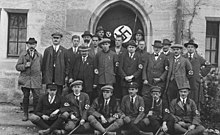
The Deutschvölkischer Schutz- und Trutzbund (German Nationalist Protection and Defiance Federation) was the largest and the most active antisemitic federation in Germany after the First World War, and an organisation that formed a significant part of the völkisch movement during the Weimar Republic (1918–1933), whose democratic parliamentary system it unilaterally rejected. Its publishing arm issued books that greatly influenced the opinions of Nazi Party leaders such as Heinrich Himmler. After the organisation folded in around 1924, many of its members eventually joined the Nazis.
Origin
The Deutschvölkischer Schutz- und Trutzbund was originally called the Deutscher Schutz- und Trutzbund when it was founded in February 1919 in Bamberg for the purpose of "fighting" Judaism during a meeting of the Alldeutscher Verband ("All-German League"). The director of Deutscher Schutz- und Trutzbund was Alfred Roth, and its secret chairman was Konstantin von Gebsattel, who was appointed on 1 October 1919 by Ernst von Hertzberg Lottin. Its advisory board included Ernst Anton Franz von Bodelschwingh, Theodor Fritsch, August Gebhard, Paul Lucius, Ferdinand Werner, Julius Friedrich Lehmann and Georg von Stössel. Its meeting place was originally in Duisburg, in Alfred Roth's house, but was later moved to Hamburg, where it joined several such other organizations. It merged with the Reichshammerbund and about a month later with the Deutschvölkischer Bund, the organization that had succeeded the Deutschvölkische Partei.
Manifesto
The organisation's manifesto was Wenn ich der Kaiser wär ("If I Were the Kaiser"), which was written by All-German League President Heinrich Claß in which he expressed identitarian and nationalist views. His slogan was "Germany for the Germans". Julius Friedrich Lehmann, a Munich publisher, helped promote the organisation's ideas, and in October 1918, Claß called for a coup d'etat. The organisation agitated against the Weimar Republic, and by 1923, it had just under 180,000 members.
Symbols
The organisation used as its symbols a blue cornflower and a swastika. According to the British author Peter Padfield its motto was "Wir sind die Herren der Welt!" ("We are the masters of the world!"). However, not a single German source can be found that confirms the motto, which in fact is a verse from the song "Der mächtigste König im Luftrevier" ("The mightiest king in the skies"). According to the German historian Ulrich Sieg, the organization's motto was Deutschland den Deutschen ("Germany for the Germans").
Excerpt of constitution
Here is an excerpt from its constitution:
The Bund fights for the moral rebirth of the German people.... It considers the pernicious and destructive influence of Jewry to be the main cause of the defeat and the removal of this influence to be necessary for the political and economic recovery of Germany, and for the salvation of German culture.
Notable members
- Herbert Albrecht
- Karl Astel
- Erich von dem Bach-Zelewski
- Werner Best
- Arthur Böckenhauer
- Ernst Boepple
- Philipp Bouhler
- Walter Buch
- Leonardo Conti
- Heinrich Deubel
- Artur Dinter
- Oskar Dirlewanger
- Dietrich Eckart
- Friedrich Karl Florian
- Theodor Fritsch
- Wilhelm Grimm
- Josef Grohé
- Heinrich Haake
- Ludolf Haase
- Wilhelm Helfer
- Otto Hellmuth
- Hans Helwig
- Reinhard Heydrich, co-architect of the holocaust
- Karl Kaufmann
- Georg Joel
- Josef Klant
- Richard Kunze
- J. F. Lehmann
- Viktor Lutze
- Walter Maass
- Eugen Munder
- Wilhelm Murr
- Martin Mutschmann
- Wilhelm Ohnesorge
- Friedrich Ringshausen
- Alfred Roth
- Bernhard Rust
- Fritz Sauckel
- Franz Xaver Schwarz
- Franz Schwede
- Wolfram Sievers
- Franz Walter Stahlecker
- Julius Streicher
- Ernst Werner Techow
- Otto Telschow
- Felix Wankel
- Karl Weinrich
- Ferdinand Werner
See also
References
Notes
- Kershaw, Ian. Hitler: 1889-1936: Hubris (1998)
- Beurteilung des Reichskommissars für Überwachung der öffentlichen Ordnung in einem Schreiben an den Staatsgerichtshof zum Schutze der Republik, 20 November 1922, quoted from Lohalm 1970, pg. 11.
- ^ Padfield, Peter. Himmler: Reichsführer SS. New York: Henry Holt, 1990. p. 107
- Kershaw, Ian. Hitler: 1889-1936: Hubris. New York: Norton (1998)
- Werner Jochmann: Nationalsozialismus und Revolution : Ursprung und Geschichte der NSDAP in Hamburg 1922 - 1933. Dokumente. Europäische Verlagsanstalt, Hamburg 1963, pg. 25.
- Ulrich Sieg, Deutschlands Prophet. Paul de Lagarde und die Ursprünge des modernen Antisemitismus, München 2007, pg. 327.
- "Deutschvölkischer Schutz- und Trutzbund (DVSTB), 1919-1924/35 – Historisches Lexikon Bayerns".
-
Sieg highlights another motto: Deutschland den Deutschen ("Germany for the Germans"). See Sieg, Ulrich (2007). Deutschlands Prophet: Paul de Lagarde und die Ursprünge des modernen Antisemitismus [Germany's Pprophet: Paul de Lagarde and the origins of modern anti-semitism] (in German). Hanser. p. 327. ISBN 978-3-446-20842-1. Retrieved 2011-10-26.
Im Oktober 1918 forderte Lehmann eninen Staatsstreich, wenig spaeter unterstuetzte er den rechstradikalen Deutsch-Voelkischen Schutz- and Trutzbund. Dessen Losung lautete 'Deutschland den Deutschen" .
- ^ Waite, p 206, quoting Alfred Roth, Aus der Kampfzeit
Bibliography
- Roth, Alfred. Aus der Kampfzeit des Deutschvölkischen Schutz-und-Trutzbundes. Hamburg, 1939
- Waite, Robert G L. Vanguard of Nazism. 1969, W W Norton and Company
External links
- Article from the Historical Dictionary of Bavaria website
- Martin Ulmer: “The Enemy is in the Country: The Jew.” Poster Stamps Printed by the Deutschvölkischen Schutz- und Trutz-Bundes (German Nationalist Protection and Defiance Federation), in: Key Documents of German-Jewish History, September 22, 2016. doi:10.23691/jgo:article-112.en.v1